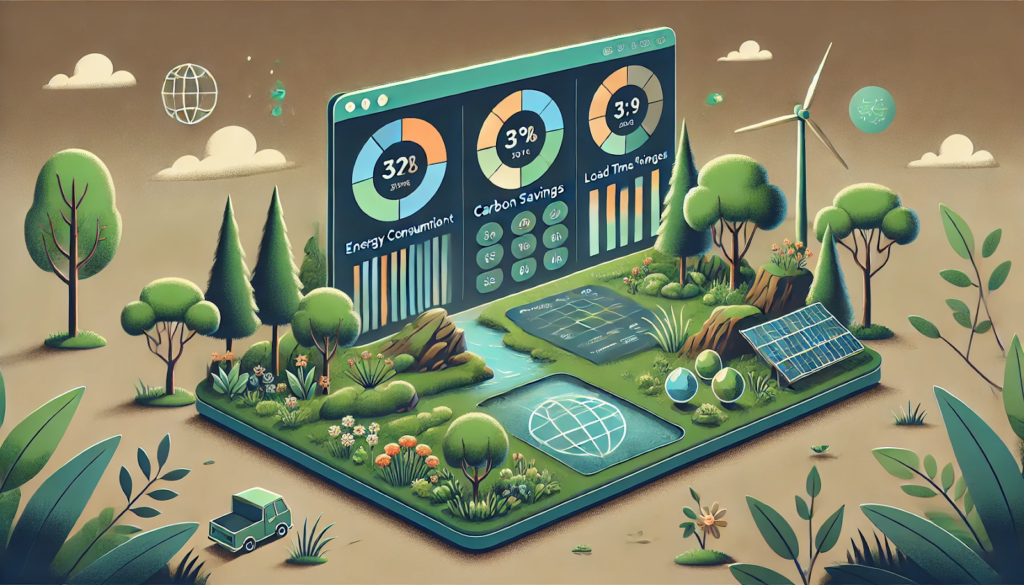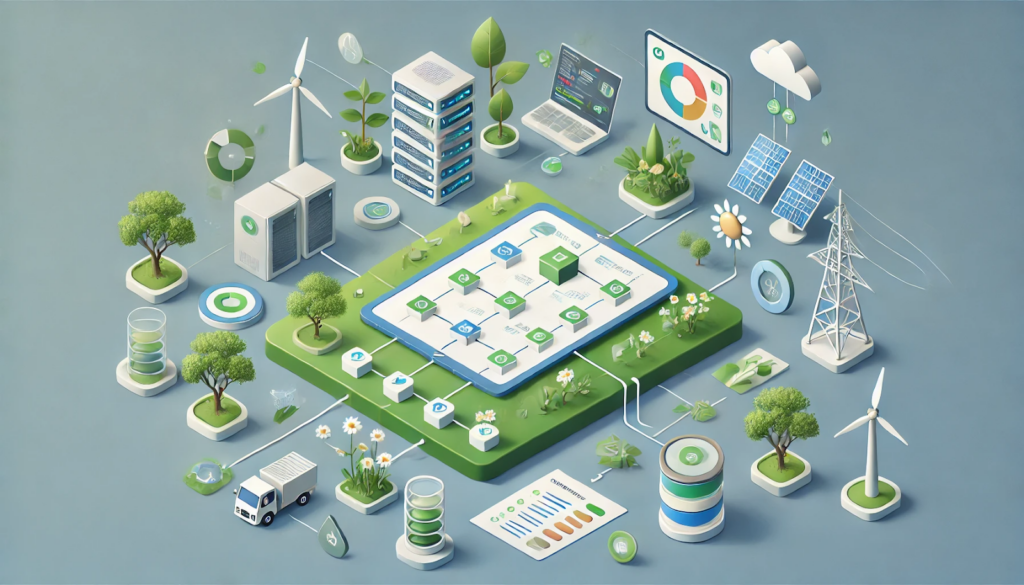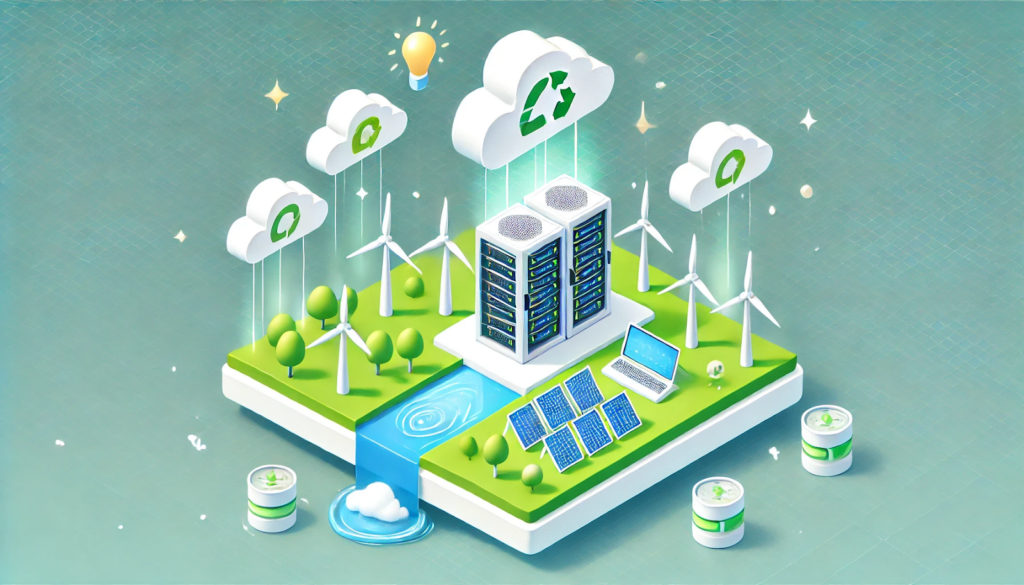Sustainable web development for greener solutions

Introduction: Why sustainability matters in web development
The web, despite its virtual nature, has a very real environmental cost. Every click, load, and stream relies on physical infrastructure — data centers, servers, and network cables — that consume significant energy. The internet’s carbon footprint rivals global aviation, contributing approximately 3.7% of global greenhouse gas emissions. With the digital world expanding exponentially, these numbers are only set to increase, creating a critical need for sustainable green practices.
Best IT company website design and development: Driving growth
- Project management software for web development: Streamline your workflow
- Sustainable web development practices: Building greener digital solutions for the future — you are here
- Website speed optimization: Boost performance with Google PageSpeed Insights
The need for sustainable practices in web development
Behind the seamless operation of a website lies an intricate network of energy consumption:
- Data centers operate 24/7, often powered by fossil fuels, to deliver content worldwide.
- User devices and network connections further contribute to the web’s substantial carbon footprint.
For example, a single website visit can produce between 0.5 and 20 grams of CO2, depending on the site’s size and efficiency. Multiply this by billions of daily interactions, and the scale becomes staggering.
Sustainability as a responsibility
Web developers and businesses bear a clear responsibility to address this impact. Beyond the ethical imperative, sustainability offers practical advantages:
- Improved user experience: Lightweight, efficient websites load faster and perform better.
- Enhanced SEO: Optimized sites rank higher in search engines.
- Alignment with consumer demand: Eco-conscious solutions resonate with today’s audiences and stakeholders.
Sustainable web practices present a win-win scenario for the planet and business outcomes.
What is sustainable web development?
Sustainable web development transcends the traditional goals of functionality and aesthetics. It focuses on creating digital solutions that minimize energy consumption, reduce environmental impact, and align with long-term ecological responsibility. But what does this mean in practice?
Definition and principles
Sustainable web development involves building websites, applications, and digital ecosystems that are optimized for energy efficiency, accessibility, performance, and longevity.
By balancing environmental stewardship with usability and functionality, developers can create platforms that deliver impactful user experiences while conserving resources.
Core principles of sustainability in web development
- Efficiency. Reduce energy use with streamlined server requests, caching, and lightweight code.
- Accessibility. Design inclusively to serve diverse users, eliminating duplicative resources.
- Performance optimization. Ensure fast-loading websites to decrease energy consumption and enhance user satisfaction.
- Longevity. Build durable solutions that adapt to future needs, avoiding wasteful redesigns.
The Sustainable Web Manifesto
Launched by Wholegrain Digital in 2019, the Sustainable Web Manifesto outlines six guiding principles for developers aiming to integrate sustainability into their work:
- Clean. Use renewable energy for hosting and operations.
- Efficient. Create digital products that minimize material and energy usage.
- Open. Promote inclusivity and transparency in design and development.
- Honest. Avoid manipulative or exploitative practices.
- Regenerative. Develop solutions that positively impact ecosystems.
- Resilient. Ensure dependability even under adverse conditions.
Key strategies for building sustainable websites
Creating sustainable websites involves more than minimizing resource-heavy visuals or coding redundancies. It’s a holistic approach that integrates performance optimization, energy efficiency, and design durability. These strategies enable developers to craft digital solutions that balance environmental responsibility with user satisfaction.
Optimizing performance for energy efficiency

Efficient websites not only load faster but also consume less energy. Performance optimization begins with improving code and content delivery.
- Minimizing HTTP requests. Combine CSS files, consolidate JavaScript, and use image sprites to reduce the number of server requests, decreasing data transfer and energy use.
- Efficient coding practices. Cleaner, more concise code shortens rendering times. Removing unused code and redundancies can save kilobytes of data per page load.
- Compressed media files. Use modern formats like WebP for images and compress video files to reduce bandwidth demands.
Reducing server load
Servers contribute significantly to a website’s carbon footprint. Lowering their workload enhances sustainability and improves performance.
- Caching. Store static content locally on user devices to avoid repeated server queries for returning visitors.
- Content delivery networks (CDNs). Distribute cached content across global servers to minimize data travel distances and reduce latency.
- Lazy loading. Delay loading non-essential resources (e.g., images below the fold) until they’re needed, reducing initial page load times and energy consumption.
Designing for longevity
Frequent redesigns can lead to wasted resources and increased environmental impact. Designing for longevity ensures websites remain relevant and resource-efficient over time.
- Modular and scalable codebases. Modular designs allow for updates or component additions without overhauling the entire website.
- Future-proof technologies. Avoid reliance on unsupported platforms or proprietary frameworks to ensure long-term usability.
- User-centric design. Build intuitive, user-friendly interfaces that remain effective without constant revisions.
Sustainable design practices
Sustainability starts with intentional design choices. By prioritizing efficiency, accessibility, and simplicity, developers can create visually appealing and functional websites that reduce their environmental footprint.
Minimalist design for lower resource use
Less is more in sustainable design. Minimalism reduces energy consumption while enhancing user experience.
- Streamlined visuals. Limit resource-heavy elements like large images, autoplay videos, and complex animations. Opt for clean typography, vector graphics, and optimized images to convey your message effectively.
- Simplified navigation. Avoid overly complex menus or interaction flows that lead to unnecessary clicks or page requests.
- Decluttering content. Ensure every element on a page serves a purpose. Eliminate redundant information to deliver only what’s essential.
Eco-friendly color palettes
Color choices impact energy consumption, particularly on OLED and AMOLED screens, where darker tones consume less energy.
- Dark mode designs. Incorporate dark mode options to enhance accessibility and reduce power consumption.
- Muted tones. Use earthy, muted tones that align with sustainability themes and are less energy-intensive than highly saturated colors on modern displays.
Accessibility as sustainability
An accessible website serves a broader audience with fewer resources, making inclusivity a key component of sustainable design.
- Inclusive design standards. Ensure text is readable, interfaces are navigable, and content is perceivable across all devices to avoid creating alternative versions.
- Efficient interaction. Simplify navigation for assistive technologies, such as screen readers, to reduce user friction and the time spent per session.
- Reusable components. Accessibility features like high-contrast modes or scalable fonts often lead to modular designs that are both future-proof and resource-efficient.
Sustainable hosting and infrastructure

Behind every website lies a network of servers, data centers, and storage solutions—components that significantly impact the environment. Choosing the right hosting and infrastructure strategies can minimize this impact, ensuring a website’s digital presence aligns with sustainable values.
Choosing green hosting providers
Web hosting is one of the most critical factors in reducing a website’s carbon footprint. Green hosting providers prioritize renewable energy and energy-efficient infrastructure.
- Renewable energy. Providers like GreenGeeks and Kualo run their servers on renewable energy sources such as wind, solar, and hydropower. Some even invest in energy credits to offset their carbon output.
- Energy efficiency. Advanced cooling technologies and energy-efficient hardware help reduce power consumption, further minimizing environmental impact.
- Commitment to sustainability. Many green hosting companies actively participate in carbon offset initiatives or contribute to reforestation projects, allowing businesses to align their digital presence with broader environmental goals.
Optimizing data storage
Reducing storage needs is not only cost-effective but also environmentally responsible. The less data is stored and transferred, the lower the energy demands on servers.
- Efficient databases. Optimizing database queries and eliminating redundant data minimizes server load and speeds up operations.
- Compressed media. Implementing compression techniques for images, videos, and other media reduces storage space requirements and data transfer loads.
- Archiving strategies. Regularly archiving inactive or outdated content helps keep active servers lean and energy-efficient.
Decentralized hosting with Content Delivery Networks (CDNs)
CDNs distribute content across multiple servers worldwide, ensuring users access data from the server closest to them. This reduces latency and energy usage.
- Reduced data travel. By serving content locally, CDNs minimize the distance data must travel, reducing carbon emissions from data transmission.
- Load balancing. Distributing traffic across multiple servers reduces the strain on individual data centers, improving overall energy efficiency.
- Hybrid solutions. Pairing CDNs with green hosting can create a sustainable infrastructure that balances performance with environmental responsibility.
Measuring and monitoring website sustainability
Sustainability is an ongoing effort, and monitoring a website’s environmental impact is critical to achieving long-term success. By focusing on relevant metrics and leveraging specialized tools, developers can measure their digital footprint and identify opportunities for improvement.
Sustainability metrics for websites

Key metrics help quantify the environmental impact of a website and provide a foundation for iterative improvements:
- Energy consumption per visit. The amount of energy required to load a page, influenced by file sizes, server efficiency, and data transfer processes.
- Carbon emissions. Websites produce CO2 emissions depending on server energy usage and user device interactions. Tools like the Website Carbon Calculator can help estimate these emissions.
- Page load times. Faster websites consume less energy per visit, making performance optimization an essential aspect of sustainability.
- Data transfer volume. Lowering the size of images, scripts, and other assets directly reduces the energy used during data transmission.
- Bounce rate and usability metrics. A poorly optimized website increases user frustration and unnecessary resource usage as users repeat searches or navigate away.
Tools for measuring impact
Several tools are designed to measure and monitor the sustainability of websites, offering actionable insights for developers:
- Website Carbon Calculator. It evaluates CO2 emissions per page load and provides comparisons to other websites.
- Ecograder. Assesses website performance, hosting choices, and overall design for sustainability.
- Google Lighthouse. Offers insights into page performance and accessibility while suggesting improvements that also enhance sustainability.
- Digital Beacon. Tracks emissions from first and repeat visits, allowing for a detailed understanding of site efficiency.
Iterative improvements for sustainability
Sustainability isn’t achieved overnight. It requires constant attention to metrics and a willingness to refine and adapt:
- Regular audits. Periodic reviews of hosting, file sizes, and performance metrics help ensure continued alignment with sustainability goals.
- Performance updates. Optimize site performance through techniques like lazy loading, script minification, and image compression.
- Adapting to new standards. Stay informed about advancements in sustainable web design practices, incorporating them into existing workflows.
Real-world examples of sustainable web development practices
Sustainable web development is being practiced by organizations worldwide. These real-world examples demonstrate innovative approaches to reducing the digital carbon footprint while delivering exceptional user experiences.
EcoHaven: Championing zero-waste through design
EcoHaven, an eCommerce platform for sustainable products, exemplifies green web development with its minimalist and energy-efficient design. Key features include:
- Optimized media. By compressing images and eliminating autoplay videos, the website significantly reduces its energy consumption.
- Green hosting. Powered entirely by renewable energy, the hosting infrastructure aligns with EcoHaven’s zero-waste philosophy.
- Interactive features for advocacy. Users are guided through eco-friendly living tips, reinforcing the company’s mission while ensuring smooth navigation.
Sitos Group: Immersive sustainability
The Sitos Group website blends stunning visuals with practical sustainability:
- Vivid storytelling. High-resolution images and videos educate users on renewable energy solutions without overwhelming the website’s load capacity.
- Interactive sustainability challenges. Visitors are encouraged to engage with interactive features promoting greener practices.
- Global accessibility. By leveraging a content delivery network (CDN), the site ensures energy-efficient content delivery worldwide.
Searious Business: Tackling plastic pollution
Searious Business tackles plastic pollution through an engaging and eco-friendly website design:
- Data visualization. Interactive infographics highlight the environmental impact of plastic waste.
- Efficient backend. Lazy loading and modular design reduce energy usage without compromising user experience.
- Educational campaigns. Visitors are prompted to join initiatives through tools integrated into the site.
Terrapass: Calculating carbon and encouraging change
Terrapass demonstrates how a web platform can empower users to act on sustainability:
- Carbon footprint calculator. This tool allows visitors to assess their personal emissions and explore strategies for offsetting them.
- Real-time impact metrics. Users see how their contributions directly impact projects, fostering transparency and trust.
- Sustainable content delivery. Optimized images and data compression reduce server load, keeping the platform efficient.
Dodonut: A lean development approach
Using the Astro JS framework, Dodonut exemplifies efficiency:
- Minimal JavaScript. By limiting JavaScript use, the site achieves faster load times and lower energy consumption.
- Static content delivery. Static site generation minimizes backend server activity, creating a highly sustainable architecture.
The Nature Conservancy: Advocacy meets efficiency
The Nature Conservancy uses its website to inspire conservation action while maintaining sustainability:
- Responsive design. The mobile-friendly interface ensures accessibility with minimal energy use.
- Impactful visuals. High-quality images enhance storytelling while optimized file formats keep load times low.
- Community tools. Visitors can engage with conservation efforts through petitions and volunteer opportunities seamlessly integrated into the site.
Challenges and solutions in sustainable web development
Sustainable web development comes with its unique hurdles, but these challenges can be mitigated through thoughtful strategies and innovative solutions. Here’s a look at some common obstacles and how developers and businesses have addressed them.
Challenge 1: Balancing sustainability with performance and functionality
Modern websites often demand rich visuals, interactive elements, and advanced functionalities, which can conflict with sustainability goals. High-resolution media and heavy backend processes increase energy consumption.
Solution:
- Lazy loading and compression. Techniques like lazy loading and image compression reduce resource demands without compromising user experience. For instance, platforms like Searious Business use lazy loading to deliver content efficiently, ensuring minimal energy waste.
- Static content generation. Tools such as Astro JS enable static site generation, reducing server dependency for dynamic content delivery while maintaining interactivity, as seen in the Dodonut example.
Challenge 2: Resistance to change

Teams and stakeholders may be hesitant to adopt sustainable practices due to a lack of awareness or fear of disrupting established workflows.
Solution:
- Stakeholder education. Initiatives like the Sustainable Web Manifesto provide resources to educate stakeholders on the long-term benefits of green practices.
- Incremental implementation. Introducing small, impactful changes — such as switching to green hosting or compressing media — helps ease the transition. EcoHaven's gradual adoption of renewable-powered hosting is a testament to this approach.
Challenge 3: Resource and budget constraints
Smaller organizations or startups may find it difficult to allocate resources toward sustainability initiatives, given the initial costs of tools, training, or technology upgrades.
Solution:
- Cost-effective tools. Open-source frameworks like GreenSpector and Lighthouse offer affordable means to analyze and improve a website’s sustainability metrics.
- Prioritizing high-impact changes. Focus on practices like caching and CDN integration, which provide immediate energy savings with minimal investment. For example, Terrapass improved sustainability by implementing a CDN, drastically lowering operational energy costs.
Challenge 4: Navigating complex sustainability metrics
Understanding and tracking a website’s carbon footprint can be overwhelming, especially for teams unfamiliar with the necessary tools or metrics.
Solution:
- Adopting simplified tools. Tools like the Website Carbon Calculator and Digital Beacon offer straightforward assessments, providing actionable insights without requiring technical expertise.
- Iterative monitoring. Regularly track and refine metrics, as seen in the practices of ClimeCo, which uses real-time impact dashboards to maintain and improve sustainability performance.
Challenge 5: Engaging clients and end-users
Convincing clients or users of the value of sustainability in web development can be challenging, particularly when they prioritize aesthetics or functionality over environmental concerns.
Solution:
- Storytelling through design. Websites like The Nature Conservancy use compelling visuals and transparent reporting to communicate the value of sustainable practices.
- Highlighting benefits. Emphasizing the dual benefits of sustainability — cost savings and improved user experience — can persuade stakeholders. For example, Sitos Group combines immersive visuals with lower operational costs to demonstrate the holistic value of their eco-conscious approach.
Tools and resources for sustainable web development practices
Adopting sustainable web practices requires the right mix of tools and resources. From analyzing a website’s carbon footprint to fostering collaboration in eco-friendly communities, here are some of the most impactful tools and avenues available to developers and businesses.
Development tools
- Website Carbon Calculator
- Provides a quick assessment of a website’s carbon emissions.
- Offers comparisons to help contextualize the environmental impact, such as showing equivalent energy usage in everyday terms.
- Widely used by platforms like Terrapass, which integrates carbon-offset recommendations based on data.
- Digital Beacon
- Tracks emissions for first and repeat visits, highlighting the impact of caching and asset optimization.
- Offers detailed insights into specific file types contributing to emissions, enabling developers to fine-tune their designs.
- Ecograder
- Scores websites based on green hosting, performance, and content efficiency.
- Suggests actionable steps for improvement, such as switching to renewable energy-powered hosting or reducing unused assets.
- GreenSpector
- Measures energy consumption across both public-facing websites and private applications.
- Supports developers in minimizing resource use, with a focus on reducing emissions tied to backend processes.
- Astro JS
- A frontend framework focused on building fast, lightweight websites by minimizing unnecessary JavaScript.
- Its adoption by Dodonut demonstrates how this tool supports both performance and environmental goals.
Learning resources
- Sustainable web design community
- A hub for articles, guides, and frameworks centered on green web development.
- Features real-world examples like Searious Business, which implemented minimalist design practices to lower energy consumption.
- Courses on platforms like Udemy and Coursera
- Specialized courses in green web development, covering topics like performance optimization, accessibility, and green hosting.
- Webinars and case studies
- Organizations like ClimeCo and Searious Business host sessions showcasing their sustainability journeys, offering insights into actionable strategies.
Community initiatives
- ClimateAction.tech
- A vibrant network of professionals dedicated to leveraging technology for climate action.
- Encourages knowledge sharing on topics such as eco-friendly coding and renewable-powered hosting.
- Sustainable Web Manifesto
- A collective commitment by developers and businesses to prioritize sustainability in their digital projects.
- Guides initiatives like those by EcoHaven, emphasizing renewable energy usage and minimalist content strategies.
- Open-source tools and frameworks
- Platforms like Green UI Kit provide reusable components for sustainable interface design, promoting energy-efficient and user-friendly digital solutions.
Building a sustainable digital future

Sustainability in web development is a necessity. The web, with all its boundless potential, is also a significant contributor to global carbon emissions, consuming vast amounts of energy and resources. But it doesn’t have to stay that way. By integrating eco-friendly practices, embracing thoughtful design, and choosing greener technologies, developers and organizations can shape a digital future that harmonizes innovation with responsibility.
Recap of key practices
From the earlier discussions, the path forward is clear:
- Optimizing website performance. Minimize load times and energy use through efficient coding, lazy loading, and content compression.
- Adopting green hosting. Choose providers powered by renewable energy to reduce your website’s carbon footprint.
- Minimalist and accessible design. Simplify visual elements and ensure inclusivity, benefiting both sustainability and user experience.
- Sustainable infrastructure. Leverage CDNs, efficient storage solutions, and scalable frameworks to build resilient, low-impact systems.
- Continuous improvement. Regularly measure and monitor your site’s environmental impact with tools like Ecograder and Website Carbon Calculator.
Every small change matters. Whether it’s switching to a green host, optimizing media files, or rethinking your design choices, incremental efforts can collectively lead to substantial environmental benefits. As developers and businesses, your influence extends far beyond the codebase. Every decision you make — every pixel you perfect — can echo across the digital landscape, shaping how users engage with technology sustainably.
Next steps
If you are ready to jump into this journey, start small but think big:
- Perform a sustainability audit of your current websites and applications.
- Educate your team on sustainable practices and encourage a culture of accountability.
- Prioritize long-term efficiency over short-term gains in design, development, and infrastructure.
- Advocate for sustainability with clients and stakeholders, showcasing the tangible benefits it brings.
Egor Kaleynik
IT-oriented marketer with B2B Content Marketing superpower. HackerNoon Contributor of the Year 2021 Winner – MARKETING. Generative AI enthusiast.
Featured in: Hackernoon.com, Customerthink.com, DZone.com, Medium.com/swlh
More info: https://muckrack.com/egor-kaleynik